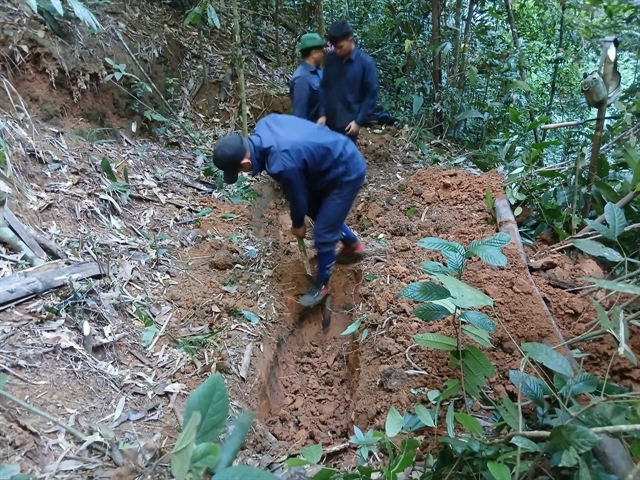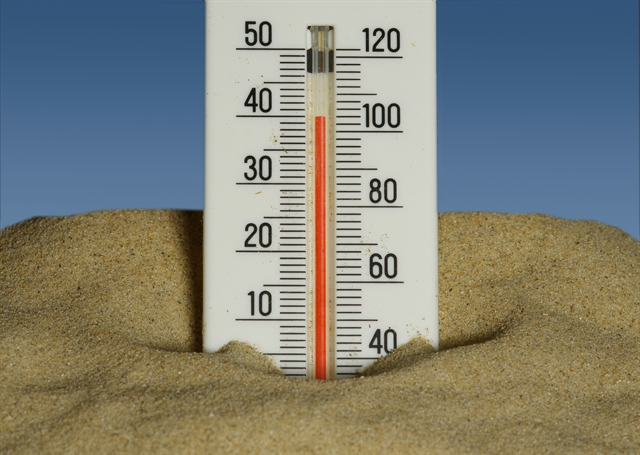 Society
Society

Experts said early action to prevent saline intrusion and reduce the affects of drought is key to protecting crops.
HCM CITY – Many areas in the Cửu Long (Mekong) Delta provinces that took early measures to cope with drought and saline intrusion have mitigated their impacts, economic officials have said.
Lê Hoàng Khương, deputy head of the Ngã Năm Town Economic Bureau in Sóc Trăng Province, said timely action taken to prevent saline intrusion meant that no rice field for the winter-spring crop was damaged.
The bureau had assigned officials to check the salt content at sluice gates every day and ordered them shut when salinity exceeded 0.2 per cent, he said.
On February 29, for instance, the town closed all its sluice gates because of excess salinity, he said.
At the beginning of the dry season, Sóc Trăng authorities foresaw the extent of saline intrusion that could happen and ordered the provincial agriculture department to carry out several measures, including buying salinity testing equipment, testing salinity at sluice gates and closing the gates when the salt content crossed safe levels.
Local officials also impressed on farmers the advantages of growing just one rice crop a year, or cultivating one rice crop and one shrimp crop a year, instead of the current practice of three crops.
Sóc Trăng has had 12,800ha of rice fields damaged by saline intrusion so far.
Nguyễn Văn Thể, secretary of the Sóc Trăng Province Party Committee, said the damaged area is not high compared to other provinces in the Mekong Delta.
Tiền Giang Province has also saved 21,500ha of winter-spring rice crop that has been threated by saline water since January, according to the province’s Sub-department of Irrigation and Storm and Flood Prevention and Control.
For this crop, coastal districts in Tiền Giang had planted nearly 30,000ha of rice, but the discovery of saline intrusion two months ago was posing a threat.
Since the end of January, the province has had to pump water into ditches alongside rice fields to save the crop.
Tiền Giang authorities also informed the people regularly about the situation of saline intrusion. Furthermore, they asked locals to practice thrift in water use.
Tiền Giang has also made plans to transport 400,000 cu.m of potable water for people in Tân Phú Đông Islet.
Clean water barges
Nguyễn Thiện Pháp, head of the sub-department, said they will use barges to transport clean water to Tân Phú Đông.
At the end of last year, An Giang Province made plans to carry out 616 irrigation works, including the dredging canals and ditches, reinforcing rice field embankments and sluice gates.
Lữ Cẩm Khường, deputy director of the An Giang Department of Agriculture and Rural Development, said: “The province has also built 26 dams to prevent salt water intrusion.”
An Giang has also built a water station for supplying clean water to people in mountainous areas in Tri Tôn and Thoại Sơn districts.
Since irrigation works require large capital investments, An Giang has sought VNĐ487 billion (US$22 million) from the central Government, Khường said.
Meanwhile, Kiên Giang Province has built 96 temporary dams to prevent saline intrusion, according to the provincial Department of Agriculture and Rural Development.
Department director Nguyễn Văn Tâm said the province will soon build another five dams.
The department has asked officials in the U Minh Thượng area to build temporary dams because there no sluice gates there to control saline intrusion.
Kiên Giang has also petitioned the central Government for US$102 billion that it needs to dredge canals and ditches.
Seven provinces in the delta – Long An, Bến Tre, Tiền Giang, Kiên Giang, Sóc Trăng, Cà Mau and Vĩnh Long – have announced a natural disaster alert because of drought and saline intrusion.
In Long An Province, saline content of 0.4 per cent has entered 80 km inland via the Vàm Cỏ Đông River and 70km inland via the Vàm Cỏ Tây River.
Drought and saline intrusion has been severe in the Mekong Delta, damaging about 139,000ha of the winter-spring rice crop thus far, an increase of 34,000ha over mid February, according to the Ministry of Agriculture and Rural Development.
To help deal with the situation, Prime Minister Nguyễn Tấn Dũng has decided to allocate VNĐ523.7 (US$23 million) billion tor 34 provinces nationwide, including nine provinces in the delta.
Saline intrusion in the delta could last until May, the National Centre for Hydrometeorology Forecasting estimates.
Loans to drought victims
In a related move, the Governor of State Bank of Việt Nam (SBV) Nguyễn Văn Bình has told credit organisations, the Social Policy Bank and SBV’s branches in the Mekong Delta region to provide credit support for local residents affected by severe drought and saline intrusion.
The governor asked them to calculate their total credit losses, and extend the time for payment and reduce interest rates for certain customers.
Credit organisations and commercial banks should base their decision to freeze debt on the provincial People’s Committees’ disaster announcements. All figures will be reported to SBV branches.
The Governor also asked credit organizations and commercial banks to continue to give loans to help restore production and support work to prevent saline intrusion.
Bình also called for financial support from credit organizations and commercial banks for local residents in localities affected by the aftermath of drought and saline intrusion, especially for ethnic minorities and difficult areas.
He asked the Social Policy Bank to give priority for poor households, including those unable to pay back loans because of the effects of saline intrusion and drought on their livelihoods.
Banks should also invest in fresh water supply and rural environmental protection works for seriously stricken areas in the Mekong Delta region. -- VNS




